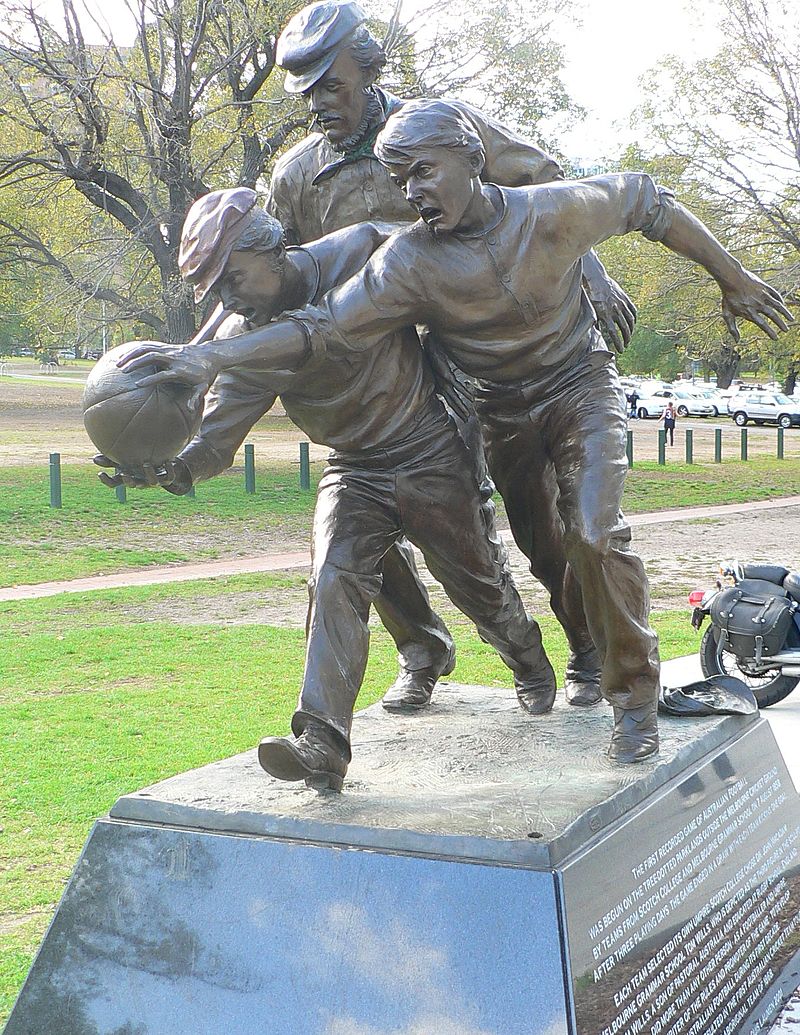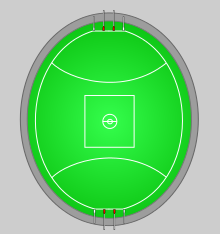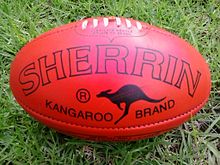Australian rules football, officially known as Australian football, or simply called Aussie rules, football or footy, is a contact sport played between two teams of eighteen players on an oval-shaped field, often a modified cricket ground. Points are scored by kicking the oval-shaped ball between goal posts (worth six points) or between behind posts (worth one point).
Australian Football
History
Australian rules football was invented in Melbourne, Australia, in 1858. The first match identified as a direct precursor to the codification of Australian football was organized and umpired by Tom Wills and contested on 31 July between Melbourne Grammar School and Scotch College, adjacent to the Melbourne Cricket Ground at the Richmond Paddock. The oldest surviving set of rules of Australian rules football were drawn up on 17 May 1859, three days after the formation of the Melbourne Football Club.
The origins of Australian football before 1858 are still the subject of much debate, as there was a multitude of football games in Britain, Ireland and Australia whose rules influenced the early football games played in Melbourne. Teams would have to agree before each match which rules would be followed, and different aspects of association football, Gaelic football, rugby football, Sheffield rules, Cambridge rules Winchester College football and Harrow football were apparent in the early games.
In the 1990s, the VFL became the Australian Football League, a national body and the premier league in Australia and later became the fact world governing body for the sport.

Laws of the Game
Field
Australian rules football playing fields have no fixed dimensions but at senior level are typically between 135 and 185 metres long and 110 and 155 metres wide wing-to-wing. The field, like the ball, is oval-shaped, and in Australia, cricket grounds are often used. No more than 18 players of each team (or, in AFL Women’s, 16 players) are permitted to be on the field at any time.
Up to four interchange (reserve) players may be swapped for those on the field at any time during the game. In Australian rules terminology, these players wait for substitution “on the bench”—an area with a row of seats on the sideline. Players must interchange through a designated interchange “gate” with strict penalties for too many players from one team on the field. In addition, some leagues have each team designate one player as a substitute who can be used to make a single permanent exchange of players during a game.
There is no offside rule nor are there set positions in the rules; unlike many other forms of football, players from both teams may disperse across the whole field before the start of play. However, a typical on-field structure consists of six forwards, six defenders or “backmen” and six midfielders, usually two wingmen, one center and three followers, including a ruckman, ruck-rover, and rover. Only four players from each team are allowed within the centre square (50 metres (55 yd)) at every centre bounce, which occurs at the commencement of each quarter, and to restart the game after a goal is scored. There are also other rules pertaining to allowed player positions during set plays (that is, after a mark or free kick) and during kick-ins following the scoring of a behind.
Match duration
A game consists of four quarters and a timekeeper officiates their duration. At the professional level, each quarter consists of 20 minutes of play, with the clock being stopped for instances such as scores, the ball going out of bounds or at the umpire’s discretion, e.g. for serious injury. Lower grades of competition might employ shorter quarters of play. The umpire signals time-off to stop the clock for various reasons, such as the player in possession being tackled into stagnant play. Time resumes when the umpire signals time-on or when the ball is brought into play. Stoppages cause quarters to extend approximately 5–10 minutes beyond the 20 minutes of play. 6 minutes of rest is allowed before the second and fourth quarters, and 20 minutes of rest is allowed at half-time.
The official game clock is available only to the timekeeper(s), and is not displayed to the players, umpires or spectators. The only public knowledge of game time is when the timekeeper sounds a siren at the start and end of each quarter. Coaching staff may monitor the game time themselves and convey information to players via on-field trainers or substitute players. Broadcasters usually display an approximation of the official game time for television audiences, although some will now show the exact time remaining in a quarter.
General play
Games are officiated by umpires. Before the game, the winner of a coin toss determines which directions the teams will play to begin. Australian football begins after the first siren, when the umpire bounces the ball on the ground (or throws it into the air if the condition of the ground is poor), and the two ruckmen (typically the tallest players from each team) battle for the ball in the air on its way back down. This is known as the ball-up. Certain disputes during play may also be settled with a ball-up from the point of contention. If the ball is kicked or hit from a ball-up or boundary throw-in over the boundary line or into a behind post without the ball bouncing, a free kick is paid for out of bounds on the full. A free kick is also paid if the ball is deemed by the umpire to have been deliberately carried or directed out of bounds. If the ball travels out of bounds in any other circumstances (for example, contested play results in the ball being knocked out of bounds) a boundary umpire will stand with his back to the infield and return the ball into play with a throw-in, a high backwards toss back into the field of play.
The ball can be propelled in any direction by way of a foot, clenched fist (called a handball or handpass) or open-hand tap but it cannot be thrown under any circumstances. Once a player takes possession of the ball he must dispose of it by either kicking or handballing it. Any other method of disposal is illegal and will result in a free kick to the opposing team. This is usually called “incorrect disposal”, “dropping the ball” or “throwing”. If the ball is not in the possession of one player it can be moved on with any part of the body.
A player may run with the ball, but it must be bounced or touched on the ground at least once every 15 metres. Opposition players may bumpor tackle the player to obtain the ball and, when tackled, the player must dispose of the ball cleanly or risk being penalised for holding the ball. The ball carrier may only be tackled between the shoulders and knees. If the opposition player forcefully contacts a player in the back while performing a tackle, the opposition player will be penalised for a push in the back. If the opposition tackles the player with possession below the knees (a low tackle or a trip) or above the shoulders (a high tackle), the team with possession of the football gets a free kick.
If a player takes possession of the ball that has travelled more than 15 metres (16 yd) from another player’s kick, by way of a catch, it is claimed as a mark (meaning that the game stops while he prepares to kick from the point at which he marked). Alternatively, he may choose to “play on” forfeiting the set shot in the hope of pressing an advantage for his team (rather than allowing the opposition to reposition while he prepares for the free kick). Once a player has chosen to play on, normal play resumes and the player who took the mark is again able to be tackled.
There are different styles of kicking depending on how the ball is held in the hand. The most common style of kicking seen in today’s game, principally because of its superior accuracy, is the drop punt, where the ball is dropped from the hands down, almost to the ground, to be kicked so that the ball rotates in a reverse end over end motion as it travels through the air. Other commonly used kicks are the torpedo punt (also known as the spiral, barrel, or screw punt), where the ball is held flatter at an angle across the body, which makes the ball spin around its long axis in the air, resulting in extra distance (similar to the traditional motion of an American football punt), and the checkside punt or “banana”, kicked across the ball with the outside of the foot used to curve the ball (towards the right if kicked off the right foot) towards targets that are on an angle. There is also the “snap”, which is almost the same as a checkside punt except that it is kicked off the inside of the foot and curves in the opposite direction. It is also possible to kick the ball so that it bounces along the ground. This is known as a “grubber”. Grubbers can bounce in a straight line, or curve to the left or right.
Apart from free kicks, marks or when the ball is in the possession of an umpire for a ball up or throw in, the ball is always in dispute and any player from either side can take possession of the ball.
Scoring
A Sherrin Kangaroo Brand football. Sherrin is the official game ball of the Australian Football League
A goal, worth 6 points, is scored when the football is propelled through the goal posts at any height (including above the height of the posts) by way of a kick from the attacking team. It may fly through “on the full” (without touching the ground) or bounce through, but must not have been touched, on the way, by any player from either team or a goalpost. A goal cannot be scored from the foot of an opposition (defending) player.
A behind, worth 1 point, is scored when the ball passes between a goal post and a behind post at any height, or if the ball hits a goal post, or if any player sends the ball between the goal posts by touching it with any part of the body other than a foot. A behind is also awarded to the attacking team if the ball touches any part of an opposition player, including a foot, before passing between the goal posts. When an opposition player deliberately scores a behind for the attacking team (generally as a last resort to ensure that a goal is not scored) this is termed a rushed behind. As of the 2009 AFL season, a free kick is awarded against any player who deliberately rushes a behind.
The goal umpire signals a goal with two hands pointed forward at elbow height, or a behind with one hand. The goal umpire then waves flags above their heads to communicate this information to the goal umpire at the opposite end of the ground.
The team that has scored the most points at the end of play wins the game. If the scores are level on points at the end of play, then the game is a draw; extra time applies only during finals matches in some competitions.









